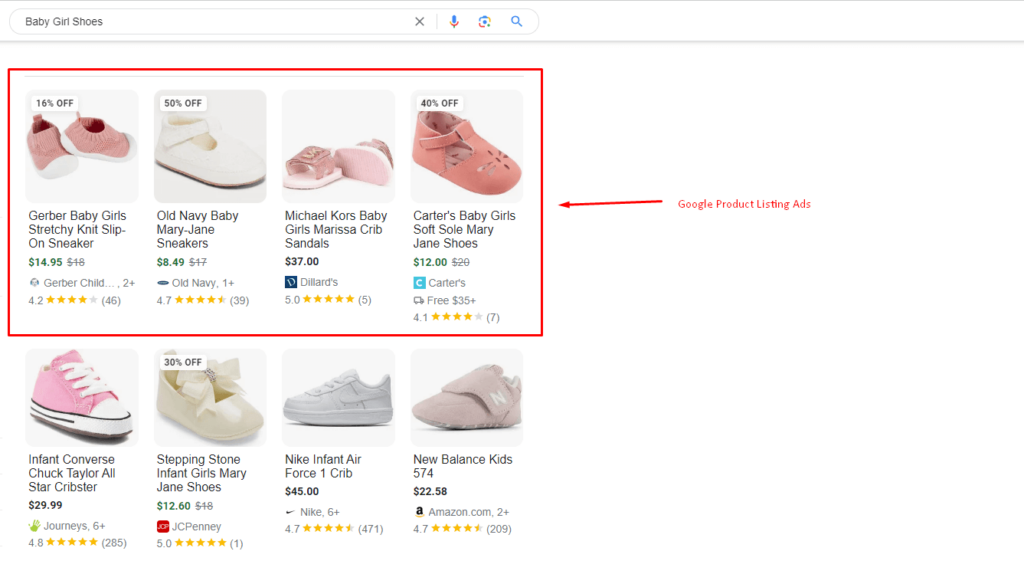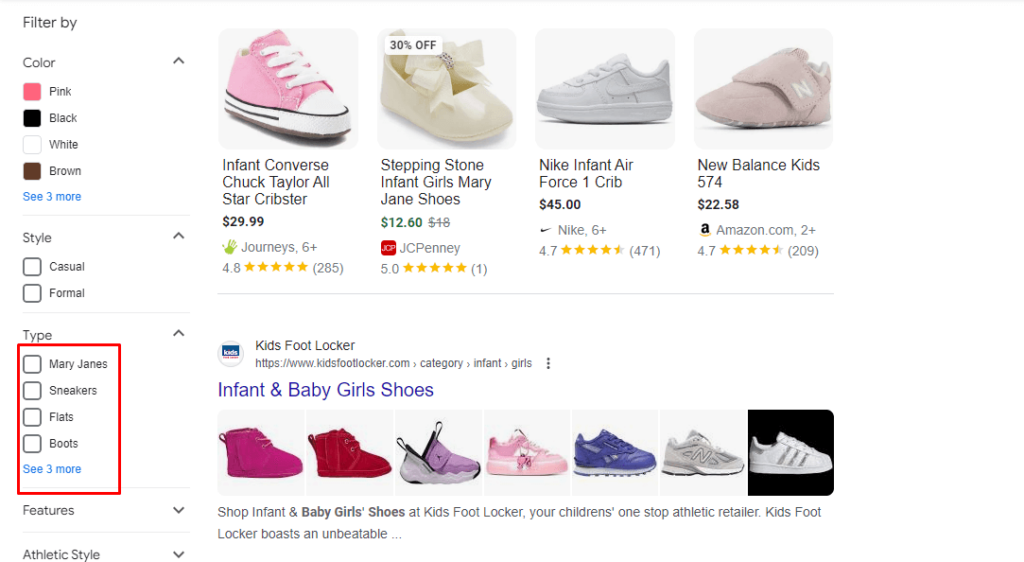Contents
- What Are Product Listing Ads?
- What are The Benefits of Using Product Listing Ads for eCommerce
- How Do Product Listing Ads Work?
- Google Product Listing Ads Optimization- Know How?
- Final Thoughts
Google Product Listing Ads Optimization: The Ultimate Guide in 2025
Do you want to make your e-commerce brand stand out in today’s busy online retail market? Google product listing ads let you display your products on Google Search and partner sites, reaching buyers when they’re searching for what you offer. It’s a powerful way to get noticed by potential customers.
And with that, let us dive into the world of Google product listing ads optimization. We offer you an ultimate guide touching on everything you need to know and the strategies you should put in place to power up your campaigns by more than a few notches.
That’s right – here, we will cover everything from developing an irresistible product feed to employing various bidding strategies. By the end of this guide, you will have the confidence needed to pull a perfect PLA campaign and claim your rightful spot on the virtual shopping shelf. So, without further ado, let’s get down to it.
What Are Product Listing Ads?
Product Listing Ads (PLAs), additionally known as Google shopping advertisements, are a type of online advertising that showcases your merchandise directly in search outcomes. They target users who are actively attempting to find objects you promote, making them a powerful device for e-trade agencies.

Here’s a breakdown of PLAs:
- Visual appeal: PLAs set themselves apart from the text-based value proposition by pulling in a product image, retailer name, price, and a short description. This visual format, which serves the purpose of drawing attention to the product, gives a quick overview to the visitors of the product of their choice on your website.
- Prominent placement: It is the case that Product Listing Ads (PLAs) are displayed in important locations on the results page within the Search Engine Results Pages (SERPs). The prominent spots are generally the top or the right side, and occasionally, only then they are presented on the “Shopping” tab and also by image search results.
- Data-driven targeting: PLAs leverage product data feeds that you upload to platforms like Google Ads. This feed includes details about your products, which Google then matches with relevant user searches.
- Pay-per-click (PPC): You typically only pay when someone clicks on your PLA and visits your website. This makes PLAs a cost-effective way to reach potential customers who are already interested in what you sell.
What are The Benefits of Using Product Listing Ads for eCommerce
Product Listing Ads (PLAs) offer several benefits for eCommerce businesses looking to promote their products effectively. Here are some key advantages.
i. Increased visibility
PLAs bring your brand to the top of search results, putting it in front of customers who are searching for a product just like yours. This creates instant brand recognition and product awareness, potentially a foot in the door for your product.
ii. Targeted reach
PLAs do not have anything to do with display ads; they are specifically meant for users who have a high commercial intent, which implies that they are in active search of purchasing something. This helps you reach a more specific target audience that is more likely to show interest in your offerings.
iii. Increased click-through rates (CTRs)
Including compelling images and relevant product information, PLAs boast higher click-through rates than regular text ads, driving more pay-per-click (PPC) quality visitors to your online store and earning you higher chances of a sale. The additional advantage of PLAs themselves on grabbing attention further works – favorably – on your engagement, as you get closer to closing more sales from shoppers even before, with PPC visitors who are usually shopping ready.
iv. Mobile-friendly
The boost in mobile shopping made Product Listing Ads (PLAs) an especially great help for mobile users with big graphic landmarks, which is ideal for much smaller screens where high-colour images can make more noise and have a clearer impact in today’s visual era. This visual touch has some play on its charm, using the limited screen to present a strong and immediate idea of a product.
v. Easy product management
Platforms such as Google Merchant Centre, control the PLA, so they make managing and policing your product data easy. For example, the ads will automatically display the most up-to-date price or stock availability. You don’t even have to think about the upkeep of your advertising materials.
Try HelpGent
See your online business grow
How Do Product Listing Ads Work?
- Product Feed: To provide Google and Bing with your product information, create a product feed. This feed contains details like product titles, descriptions, prices, and images.
- Upload to Merchant Centers: Upload your product feed to Google Merchant Center (for Google) and Microsoft Merchant Center (for Bing).
- Matching User Queries: When a user searches for a product online, search engines use the product information from your feed to find a match.
Google Product Listing Ads Optimization- Know How?
Optimizing Google product listing ads (PLAs) involves several strategic steps to ensure your ads reach the right audience, drive traffic, and convert potential customers efficiently. Here’s a comprehensive guide to help you get the best out of your Google PLAs.
1. Optimize product feed
i. Product titles and descriptions
Incorporate relevant keywords in product titles and descriptions since Google uses these for matching search queries. Clear and concise titles should include critical details such as brand, color, size, and attributes.
According to a study by Sidecar, optimized titles can increase click-through rates (CTR) by up to 15%.
ii. High-quality images
Use multiple high-quality images showing different angles, adhering to Google’s image requirements to avoid disapproval. Images with a white background tend to perform better, as they are cleaner and more professional. Research by Shopify shows that high-quality images can increase conversion rates by 30%.
iii. Product categories and attributes

Ensure accurate categorization of products and fill in as many product attributes as possible. According to Google, providing detailed attributes can enhance ad relevance and improve visibility, potentially increasing conversion rates by up to 20%.
2. Use custom labels
You can use custom labels to break up products into categories – which in turn allows you to manage bids and budgets for each much more efficiently. One idea is to tag what we might call your ‘best sellers’ so that you spend more on those products. A case study by CPC Strategy found that using custom labels improved ROAS by 25%.
3. Bid management
i. Manual bidding
Adjusting bids based on performance data ensures efficient use of the budget. Increasing bids for high-converting products and decreasing them for low performers can optimize spending. Studies show that manual bid adjustments can lead to a 10-20% increase in conversion rates.
ii. Automated bidding
Enhanced CPC (eCPC) automatically adjusts manual bids to maximize conversions, and Target ROAS sets bids based on the desired return on ad spend. According to Google, advertisers using automated bidding see a 15% increase in conversions on average.
4. Negative keywords
Implementing negative keywords prevents irrelevant traffic, which can waste the budget. Regularly reviewing search terms and adding negatives can improve CTR and reduce cost per click (CPC).
A report by WordStream indicates that effective use of negative keywords can lower CPC by 20-30%.
5. Campaign structure
Organizing campaigns by product categories, brands, or other logical groupings allows for better control and analysis. A granular structure enables precise bidding and budget allocation, improving performance metrics. According to Google, structured campaigns can increase CTR by up to 20%.
6. Review and optimize performance
Regularly analyzing key metrics like CTR, CPC, conversion rate, and ROAS is crucial. A/B testing different strategies, such as bidding techniques and ad copies, helps identify the most effective approaches. Data from AdEspresso suggests that regular optimization can boost ROI by 30-40%.
Adjusting budget allocation and bids based on performance data ensures efficient resource use. For example, shifting the budget towards high-performing products can significantly enhance overall campaign efficiency.
7. Leverage promotions and reviews
Using promotional text in ads highlights sales, discounts, or special offers, which can increase CTR. Google Merchant Promotions integrates these offers directly into ads, enhancing visibility. Data from Google shows that promotions can increase CTR by up to 20%.
Moreover, encouraging customer reviews and integrating them into product listings enhances credibility. According to a study by Spiegel Research Center, displaying reviews can increase conversion rates by 15-20%.
8. Use smart shopping campaigns
Smart Shopping campaigns leverage Google’s machine learning to automate ad placement, bidding, and targeting, simplifying campaign management. They combine standard Shopping and display remarketing, which can extend reach and efficiency. Google reports that advertisers using Smart Shopping campaigns see an average increase in conversion value of 30%.
9. Enhance mobile experience
Optimizing the mobile shopping experience is crucial as a significant portion of traffic comes from mobile devices. Ensure mobile-friendly site design and fast loading times, as mobile shoppers are likelier to abandon slow sites. According to Google, mobile-optimized sites can see a 27% increase in conversion rates.
Final Thoughts
To excel with Google Product Listing Ads (PLAs), businesses should prioritize optimizing their data feeds, managing bids strategically, refining targeting methods, crafting engaging ad content and imagery, continually monitoring performance, and leveraging additional features provided by Google.
By implementing these strategies, advertisers can significantly improve the visibility, relevance, and overall effectiveness of their PLA campaigns, leading to increased engagement and conversions on Google’s platform.




Leave a Reply
You must be logged in to post a comment.